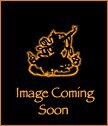
Item: Avalokiteshvara (Bodhisattva & Buddhist Deity) - Sahasrabhujalokeshvara (11 faces, 1000 Hands)
| Origin Location | Tibet |
|---|---|
| Date Range | 1800 - 1899 |
| Lineages | Gelug and Buddhist |
| Material | Ground Mineral Pigment on Cotton |
| Collection | Private |
Alternate Names: Lokeshvara Avalokita Lokanata Lokanatha Mahakarunika
Classification: Deity
Appearance: Peaceful
Gender: Male
Avalokiteshvara, Sahasrabhuja Ekadasamukha (Tibetan: chen re zig, chag tong shal chu chig. English: the All Seeing Lord with One Thousand Hands and Eleven Faces): from the tradition of Bhikshuni Shri along with the lineage teachers of the Gelug Tradition.
Avalokiteshvara in this form is peaceful in appearance, with eleven heads, one thousand hands and upright in a standing posture.
At the top center is Amitabha Buddha with Bhikshuni Shri seated slightly lower on the left side and a teacher of the Gelug tradition seated slightly below on the right side.
At the upper left side is Tsongkapa with the two principal students Gyaltsab and Khedrub. At the right side is Padmasambhava, Shantirakshita and Trisongdetsen.
Descending on the left side are the two female deities Chunda and Sitatapatra. Descending on the right side are Marichi and Sarasvati.
At the bottom left side is the standing form of Manjushri, orange in colour, holding a sword and book. On the right side is a standing Vajrapani, blue in colour and holding a vajra scepter.
At the lower left is White Tara and on the right side is Green Tara.
Lineage of Teachers: Avalokiteshvara, Bhikshuni Shri, Dawa Shonnu, Pandita Jnanabhadra, Balpopa Nyewa, Jangsem Dawa Gyaltsen, Nyi Phugpa Chokyi Dragpa, Pupa Dorje Gyalpo, Shangton Drajig, Chidul Tugje Jangchub, Khenchen Dechenpa, Chuzangpa Wangchug Bar, Sherab Bum, Gyalse Togme, Buddhashri, etc.
There are a number of different forms and traditions of the Eleven-faced Lokeshvara. The original Sanskrit source literature is the Arya Avalokiteshvara Ekadashamukha Nama Dharani. In this text there is only a mention of the eleven faces with no mention of colour or arrangement of the faces. There is also no mention about arms, or number of arms.
With the form of Lokeshvara having one thousand arms the source literature is the Maha Karunika Dharani Sutra where the one thousand arms are clearly stipulated. In that text there is no mention of the faces, even one face or any number of faces.
Both of the texts have a dharani for Lokeshvara and that dharani appears to be the same for both texts. It is approximately one hundred syllables in length. A short mantra is also taught in the later traditions of the Eleven Faced and Thousand Armed Lokeshvaras, although no short mantra is found in the two early texts. The short mantra in later traditions is borrowed from the Karandavyuha Sutra - om mani padme hum.
Jeff Watt 3-2016
Collection of Dhargye Museum
Buddhist Deity: Avalokiteshvara (Eleven Faces)
Collection of Dhargye Museum (Painting Gallery 1)
